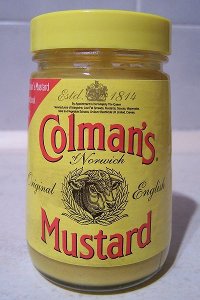Colman’s Mustard
Jeremiah Colman was once asked to sum up the secret of his success and how he made a fortune out of such a humble thing as mustard. His reply was that he made his money from the mustard that people left on the sides of their plate. There just has to be a moral there somewhere.
In 1804 he was a flour miller and decided to try his hand at the milling and packaging of mustard. Such was his success and such was the popularity of his product, that he was forced to expand, and became the largest maker of mustard in the country. Today it is prepared in very much the same way that Jeremiah Colman invented. They use two types of mustard seed, one white and the other brown. The seed is ground and sifted to remove the husks and thus form the mustard flour. After grinding and sifting, the two mustards are mixed together and packaged in the bright yellow tins that are familiar to everyone.
If the strength of a country were judged on its mustard, we in the UK would be International Supermen (and women). Take for example the Dijon mustards of France. They are very smooth, very sophisticated, but very WEAK. And what of the dark German mustard? Or the light coloured American mustard? Neither are what I would call mustard, in the real sense of the word. They are more of a relish, manufactured for those with a weak palate. Mustard should be HOT, it should clear your sinuses the moment you open the can, and should make your toes curl up if you slap too much on your ham sandwich.
Colman’s mustard is as English as the roast beef dinners that it enhances. I personally prefer to mix it fresh immediately before using it. Use cold water, mix slowly humming Rule, Britannia!, and stand for ten minutes as this gives it more of a “kick”. It is perfectly acceptable to use the ready mixed mustard that is more and more in use today, provided that it is Colman’s of course. I have actually seen jars with what is described on the label as “English” mustard, produced in Italy! As an aside, I can only comment that if in fact they had used English mustard themselves, they would probably not have lost the Roman Empire.
Colman’s mustard has of course many uses other than spicing up your Sunday roast. The following are a sample, which I have trawled from the Web. I cannot personally vouch for most of them, but intend to experiment as and when the occasion arises:
Some uses of mustard
For smelly dishes add a heaped tablespoon of Colman’s with the soap to remove odours like fish and onions.
Make a paste with Colman’s and spread it on the back of a loose tile to secure it to the wall. Acts like plaster!
 Use as fertiliser for better coloured daffodils.
Use as fertiliser for better coloured daffodils.
Sprinkle dry mustard inside shoes to prevent cold feet and frostbite.
Mustard and honey at bedtime for coughs, a pinch of mustard in a glass of water for hiccups.
Colman’s poultry mustard fed to chickens stimulates egg production.
To mend leaky car radiators temporarily, pour in contents of 2 oz tin of mustard while car is running.
Sprinkle over plants to rid them of insect pests.
Dry Colman’s rubbed into dog’s coat helps stop distemper. Cover dog with blanket.
Smear headlights with a dry Colman’s mixed with some water to drive in fog. Voilà, fog lights!
Stuffy nose? Make a paste, spread it generously over a cracker, and take a few bites. This clears it up in seconds!
Do you have trouble with ants? Sprinkle Colman’s mustard over their trail and they won’t cross it.
Hands smell like onions or garlic? Rub some Colman’s on your hand and rinse with warm water to remove the smell.
When using breadcrumbs on chicken or chops, add a tablespoon of Colman’s to the breadcrumbs.
Before cooking mussels, put them in a bucket of water with a few teaspoonfuls of dry Colman’s to make them spit out the grit and sand.
Make a paste and rub it on the sole of the foot and around the ear lobes. This is very relaxing and reduces stress.
Use a thin mixture of Colman’s and water to catch worms for fishing. You have to find a wormhole, and pour the mixture in. The worms wiggle out and then you need to rinse them off before putting them in your bait box.
Uses around your computer
Colman’s Mustard makes a great background colour for Web pages.
The nice mellow yellow colour relieves eyestrain.
Make a great looking paperweight out of the tin!
So that is Colman’s mustard for you, £1 – £1.30 for a jar or 75p or so for the famous tin. Far too strong for most countries….sniff….makes you proud to be British.
For recipes, food news and reviews please visit our sister site:

2 Responses to “Colman’s Mustard”
Dijon mustards weak??!!!???. I love both Colmans and Dijon but I can assure you Dijon mustards aren’t weak, they are some of the most powerful mustards I’ve come across.
Some Dijon mustard’s are hot, but in general they are limp, and none of them are as hot as Colman`s Mustard